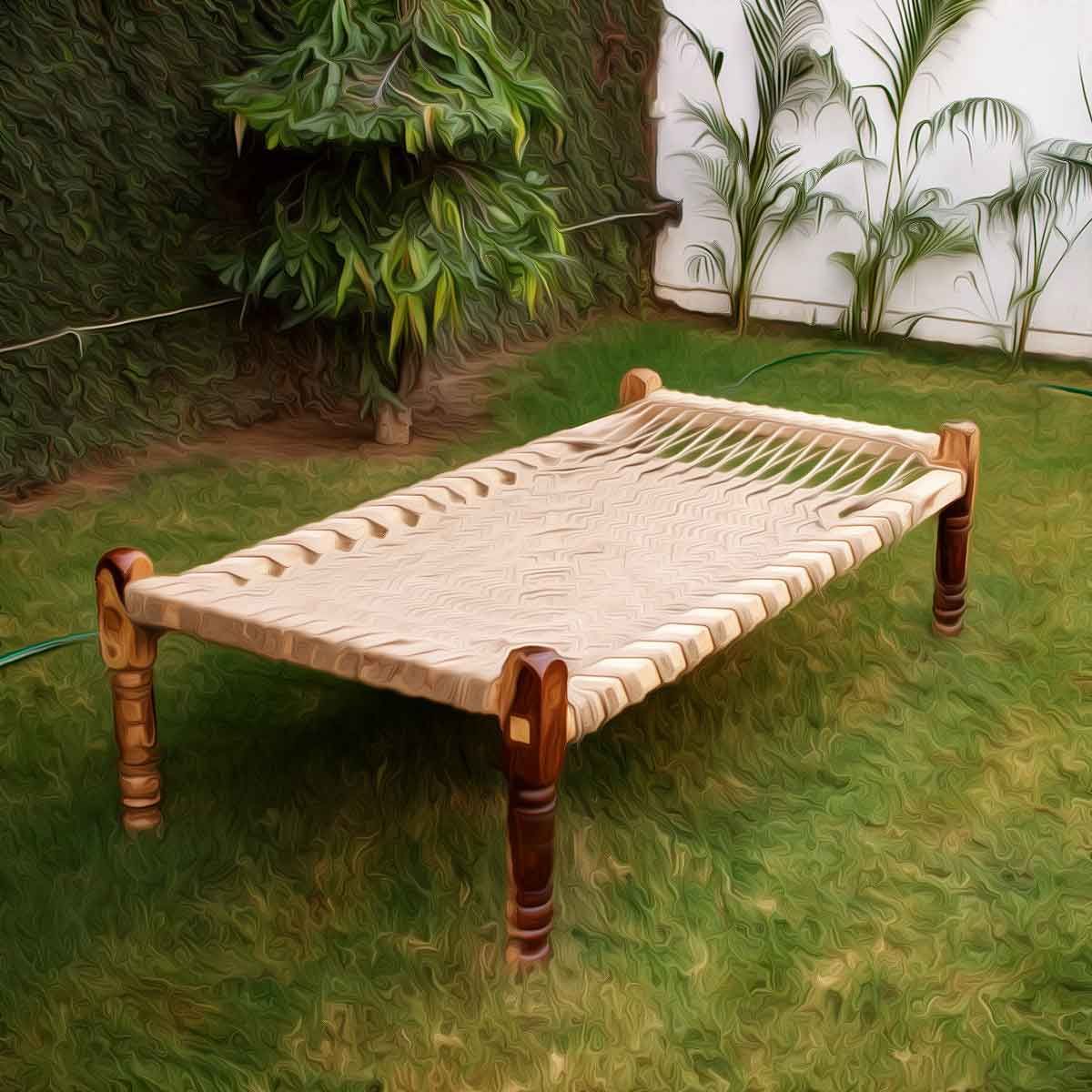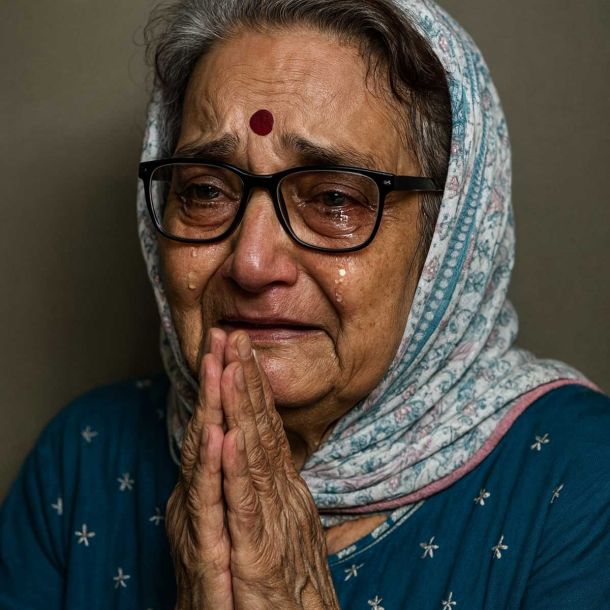More Coverage
Twitter Coverage
Satyaagrah
Written on
Satyaagrah
Written on
Satyaagrah
Written on
Satyaagrah
Written on
Satyaagrah
Written on
Join Satyaagrah Social Media
"Excessive increase of anything causes a reaction in the opposite direction": Bizarre! American e-commerce website sells Indian ‘charpai’ for a staggering ₹1.12 lakh, which is an integral part of our rural life and a symbol of simplicity and functionality

Months after the ordinary Grandpa shorts became viral for their high price, here's another household item that has become the talk of the internet, and any guesses why? Obviously for its exorbitant price.
|
Online marketplaces have made it possible to buy and sell almost anything, including some truly bizarre and outrageously priced items. Remember Balenciaga’s destroyed sneakers and handbags looking like ‘thailas‘ selling for $625 and $2090, respectively? If you thought such staggering prices of commonly available products are limited to foreign items alone, you might be wrong! An e-commerce site in the United States is offering a traditional Indian charpai for an exorbitant price.
The charpai is a basic bed constructed from wood and woven jute ropes and typically retails in India for approximately Rs 2,000-10,000. However, on Etsy, it is being sold for approximately 1.12 lakh by an Indian seller.
It is described as a “traditional Indian bed with very beautiful decor,” made from high-quality materials and crafted by hand. The charpai measures 36 inches in width, 72 inches in height, and 18 inches in depth.
The reason for the inflated price remains unclear – if it is due to the unique design and superior craftsmanship or simply due to the high demand for Indian products in the US. Whatever the reason, the charpai’s exorbitant price has sparked a debate online, with many people expressing outrage.
“Unbelievable! Our desi charpai is being sold for over Rs.1 lakh in the US and many are purchasing it.,” a user tweeted.
|
Another user wrote, “Dear Americans, in 1 lakh, you guys can travel India for 3-4 days even after buying Charpai from India and its transportation cost.”
|
This is not the first instance of an Indian product being sold for an exorbitant price on a US e-commerce site. In recent years, items such as a bucket that sold for Rs 25,999 and a plastic bag that sold for Rs 14,999 have garnered attention for their shockingly high prices.
From a plastic ‘baalti’ being sold for Rs 25,999 to Balenciaga’s Rs 1.5 lakhs ‘Shopper Bags’, we have seen a lot of mundane products sold for exorbitant prices and we have no clue why!
Twitter user Arshad Wahid shared a picture of a very ordinary-looking pair of shorts that reminds us of the kachcha our dads and dadaiji wear all the time. What’s special about this pair of knickers?
Wahid was taken aback when he saw this online. Hence, he took the screengrab of it and shared it online for people to share their two cents on the matter with the caption, “why is this pattapatti trouser 15k?”
|
Maybe it’s inspired by the shorts that Kobe Bean Bryant, an American professional basketball player, wore when he was alive, or probably it will not clutter our landfills and dissolve into the soil after being over-used. I don’t know, my middle-class mind wants some explanation behind the pricing.
Also, I now have a newfound respect for my dad’s kachcha that more often than not, turns into an effective pocha at my very desi household.
The Indian charpai, a traditional woven bed
The Indian charpai, a traditional woven bed, has emerged as a symbol of cultural heritage and craftsmanship. With its intricate designs and sturdy construction, the charpai has captured the imagination of people across the globe. Its rich history, deeply rooted in Indian traditions, showcases a remarkable blend of artistry, comfort, and health benefits. In this article, we delve into the origins and evolution of the Indian charpai, explore its cultural significance, and shed light on its numerous health benefits.
A charpoy is a flatbed of woven webbing stretched on a wooden form on four legs. It is appealingly modest in design. Simple, readily available materials are typically used.
The charpoy is used as a:
- daybed for resting
- a platform for public speaking or religious preaching
- a platform for small communal meetings
The charpoy is also known as charpai, charpai, khatiya, khaat, or manji all literally meaning ‘four feet’.
Elaborate or highly decorated charpoys are historically less common and reserved for privileged classes.
Today, the traditional charpoy is experiencing a revival with a modern twist. Versions in bright colours and modern materials have become popular among fashion-conscious consumers in the cities, as well as an export opportunity.
|
Origin and Evolution
The charpai, also known as a cot or a charpoy, can be traced back centuries to ancient India. Its design reflects the ingenuity of Indian craftsmen who sought to create a comfortable and practical bed using locally available materials. Traditionally, the charpai consists of a wooden or metal frame, interwoven with ropes made from natural fibers such as jute or cotton. Over time, the charpai's design has undergone modifications to suit regional preferences and requirements.
The charpoy was sufficiently widespread to attract the attention of Ibn Battuta, the great 14th-century Moroccan scholar. This widely-traveled explorer wrote in 1350:
The beds in India are very light. A single man can carry one and every traveller should have his own bed, which his slaves carries about on his head. The bed consists of four conical legs on which four staves are laid; between the plait a sort of ribbon of silk or cotton. When you lie on it you need nothing else to render the bed sufficiently elastic.
Today daybeds based on the same basic design are widespread throughout southeast Asia, Pakistan, Bangladesh, and India. Charpoys were also a common sight among Indian immigrants who settled in other British colonies, such as Malaysia.
Unlike other age-old traditional items such as the charka, or spinning wheel, the charpoy never found a place of symbolism in political activism.
However, the humble charpoy is also experiencing something of a modern revival and makeover with versions in bright colors and modern materials popular among fashion-conscious consumers in the cities.
The charpai's design is simple yet effective, consisting of a rectangular or square frame made of wood or metal, with woven ropes or jute strings stretched across as the sleeping surface. The ropes are tightly woven to provide support and allow for ventilation.
Over time, the charpai became a popular and practical choice for sleeping in the hot and humid climate of the Indian subcontinent. The evolution of the charpai has been influenced by various factors, including regional customs, available materials, and craftsmanship. Different regions have their own variations in terms of design, materials, and weaving patterns. In some areas, the charpai frames are intricately carved and decorated, showcasing the skill of local artisans.
In recent years, there has been a resurgence of interest in the charpai due to its rustic charm, eco-friendliness, and cultural significance. It has gained attention as a sustainable and handmade alternative to modern furniture. Designers and enthusiasts have incorporated charpai into contemporary interiors, giving it a new lease of life.
|
Cultural Significance
The Indian charpai holds immense cultural significance and has become an integral part of the Indian way of life. It symbolizes warmth, hospitality, and community bonding. In rural areas, the charpai often serves as a multipurpose piece of furniture, acting as a seating arrangement during the day and transforming into a bed at night. It is a common sight to see people relaxing on charpais, engaging in conversations, or simply enjoying the outdoors. The charpai is also deeply associated with Indian weddings, where it is used as a ceremonial seat for the bride and groom during certain rituals.
In rural India, the charpai holds significant cultural importance and is deeply intertwined with the daily lives of people. Here are some aspects that highlight its cultural significance in the rural Indian context:
Sleeping Arrangement: The charpai serves as the primary sleeping arrangement in many rural households. It is a symbol of simplicity and functionality, providing a comfortable and elevated surface for sleeping. It is especially preferred in hot and humid regions due to its ventilation properties, allowing air to circulate and keeping the sleeper cool.
Community Bonding: The charpai often acts as a communal space for social gatherings and interactions. In rural areas, it is common to find charpais arranged in courtyards or under trees, where people gather to chat, share stories, play games, or simply spend leisure time. It fosters a sense of community bonding and facilitates social connections.
Rituals and Ceremonies: The charpai plays a significant role in various rural rituals and ceremonies. For example, during weddings, the bride and groom often sit on a decorated charpai as part of the traditional customs. It also serves as a seating arrangement for community meetings, religious ceremonies, and other cultural events, emphasizing its importance as a communal space.
Craftsmanship and Artistry: The charpai is often handcrafted by skilled artisans using traditional techniques passed down through generations. The craftsmanship involved in creating intricate designs, carvings, and weaving patterns on the charpai is highly valued and showcases the artistic heritage of the region. It represents a fusion of practicality and artistic expression.
Symbol of Simplicity and Rural Life: The charpai is often associated with the simplicity of rural life in India. It symbolizes a connection to nature, traditional values, and a slower pace of life. Its presence in rural households reinforces a sense of cultural identity and heritage, reminding people of their roots and traditions.
Sustainable and Eco-Friendly: The charpai's use of natural materials like wood and ropes or jute strings makes it an eco-friendly choice. In a time when sustainable living is gaining importance, the charpai represents a traditional and sustainable alternative to modern furniture, resonating with the growing interest in eco-conscious practices.
Overall, the charpai in the rural Indian context goes beyond being just a bed. It serves as a gathering place, a symbol of tradition, and a reminder of the simplicity and cultural values that rural communities hold dear. It holds a special place in the hearts and lives of rural Indians, representing their cultural heritage and way of life.
|
Artistry and Craftsmanship
One of the charpai's most captivating aspects is the intricate craftsmanship that goes into its creation. Skilled artisans employ traditional techniques passed down through generations to weave elaborate patterns and motifs into the ropes. These designs showcase the rich cultural heritage of the region and are often inspired by nature, geometric shapes, or religious symbols. The craftsmanship involved in making a charpai has earned it recognition as a piece of art, with many artisans being awarded for their skills and contribution to the preservation of this craft.
Health Benefits
Apart from its cultural significance and aesthetic appeal, the Indian charpai offers several health benefits. Its construction allows for proper ventilation, ensuring air circulation that helps in maintaining a cool and comfortable sleeping surface. The woven ropes provide a supportive yet flexible base, promoting proper spinal alignment and reducing the risk of back pain. Additionally, the charpai's raised design allows for air to flow freely beneath the bed, reducing the likelihood of mold, mildew, and dust mite accumulation.
Here are some of the health benefits associated with using a charpai in the Indian context:
Improved Posture: The design of the charpai promotes a better posture while sleeping or sitting. The firm yet flexible surface provided by the woven ropes or jute strings helps distribute body weight evenly, thereby reducing the chances of developing posture-related issues such as back pain, spinal misalignment, or muscle strain.
Spinal Alignment and Back Support: The natural elasticity of the charpai's woven surface allows it to contour to the body's shape, providing optimal support to the spine. This helps maintain the natural curvature of the spine, preventing spinal misalignments and reducing the risk of backaches or discomfort associated with poor sleeping surfaces.
Enhanced Blood Circulation: The firm support of the charpai allows for better blood circulation during sleep. Unlike softer mattresses that can restrict blood flow to certain areas of the body, the charpai's firmness promotes even distribution of pressure, reducing the chances of numbness or tingling in limbs and improving overall blood circulation.
Improved Sleep Quality: The natural ventilation provided by the charpai's woven surface allows for better airflow, keeping the body cool and preventing excessive sweating. This can help promote a more restful sleep, particularly in hot and humid climates prevalent in many parts of India.
Allergy Reduction: Compared to mattresses that can accumulate dust, allergens, and bed mites, the charpai's woven surface is less prone to such issues. The open design of the charpai allows for better air circulation, minimizing the accumulation of dust and allergens. This can be particularly beneficial for individuals with allergies or respiratory conditions.
Eco-Friendly and Sustainable: The use of natural materials in the construction of a charpai, such as wood and ropes or jute strings, makes it an eco-friendly and sustainable choice. Unlike mattresses made of synthetic materials, charpais do not contain harmful chemicals or emit volatile organic compounds (VOCs), which can be beneficial for individuals with chemical sensitivities.
Cost-Effective: Charpais are often more affordable compared to modern mattresses, making them accessible to a wider population. This affordability ensures that individuals from various socioeconomic backgrounds can have access to a comfortable and supportive sleeping surface that contributes to their overall health and well-being.
It is important to note that while charpais offer certain health benefits, individual preferences, and specific health conditions may vary. It is always advisable to consider personal comfort, and body requirements, and seek professional advice if needed to determine the most suitable bedding option for optimal health and sleep.
Furthermore, sleeping on a charpai can help alleviate certain health conditions such as arthritis or joint pain. The natural elasticity of the woven ropes gently contours to the body's shape, relieving pressure points and enhancing blood circulation. This unique feature makes the charpai an excellent choice for those seeking a comfortable and healthy sleeping option.
Conclusion
The Indian charpai stands as a testament to the country's rich cultural heritage, craftsmanship, and practical ingenuity. With its timeless design, the charpai has not only become an iconic symbol of Indian tradition but has also gained global recognition for its aesthetic appeal and health benefits. As we appreciate the intricate artistry and history woven into each charpai, let us cherish and preserve this unique piece of furniture that continues to bring comfort, culture, and wellness to people's lives.
 Support Us
Support Us
Satyagraha was born from the heart of our land, with an undying aim to unveil the true essence of Bharat. It seeks to illuminate the hidden tales of our valiant freedom fighters and the rich chronicles that haven't yet sung their complete melody in the mainstream.
While platforms like NDTV and 'The Wire' effortlessly garner funds under the banner of safeguarding democracy, we at Satyagraha walk a different path. Our strength and resonance come from you. In this journey to weave a stronger Bharat, every little contribution amplifies our voice. Let's come together, contribute as you can, and champion the true spirit of our nation.
 |  |  |
| ICICI Bank of Satyaagrah | Razorpay Bank of Satyaagrah | PayPal Bank of Satyaagrah - For International Payments |
If all above doesn't work, then try the LINK below:
Please share the article on other platforms
DISCLAIMER: The author is solely responsible for the views expressed in this article. The author carries the responsibility for citing and/or licensing of images utilized within the text. The website also frequently uses non-commercial images for representational purposes only in line with the article. We are not responsible for the authenticity of such images. If some images have a copyright issue, we request the person/entity to contact us at This email address is being protected from spambots. You need JavaScript enabled to view it. and we will take the necessary actions to resolve the issue.
Related Articles
- Chronicles of Valour- The Battle of Haldighati
- Unsung Heroine Pritilata Waddedar, Who Shook The British Raj at the age of 21
- 21-yr-old girl Bina Das shot Bengal Governor in her convocation programme at Calcutta University, got Padma Shri but died in penury
- Freedom struggle of Gurjars against Britishers at Koonja in 1824: 100s of Gurjars Martyred and 100s Hung in Single Tree
- The power of Sanatana Dharma and Fact Analysis of the Supernatural Fire Yogi of Tanjore
- Kartar Singh Sarabha - The Freedom fighter who was Hanged at the age of 19 and inspired Bhagat Singh
- Toxic Western ideologies being pushed into Indian schools via promoting LGBT and gender politics propaganda among children
- Savitri Devi broke into tears when Yogi Adityanath decided to leave for Gorakhpur to take vow of sainthood, and today her eyes contain the same tears brimming with pride Yogi has emerged as a Chief Minister of Uttar Pradesh
- "Embrace the light within and discover the boundless expanse of enlightenment": IIT Kanpur, renowned for its remarkable advancements in science and technology embarks on a sacred endeavor to digitize and disseminate Indian philosophical texts, and Vedas
- 16 year old freedom fighter Shivdevi Tomar, who killed 17 Britishers and wounded many
- Tirot Singh: An Unsung Hero of the Khasi Tribe who destroyed British with his skill at Guerrilla Warfare
- Dangers of losing our identity: Guru Tegh Bahadur forgotten and Aurangzeb being glorified
- The Balliol college at the University of Oxford has dedicated a new building after Dr. Lakshman Sarup, the first candidate at Oxford to pass his thesis for a Doctorate of Philosophy (DPhil) degree on Sanskrit treatise on etymology
- Rana Sanga, the symbol of bravery who defeated Sultan Ibrahim Lodhi and fought Muslim Terrorists for Hindu Existence
- Five words, “Sisters and Brothers of America” addressing about seven thousand people was followed by applause which lasted for almost 3 minutes: Why the 1893 speech of Swami Vivekananda at World’s Parliament of Religions is still relevant today
























